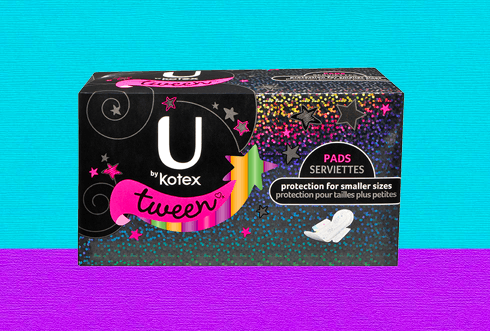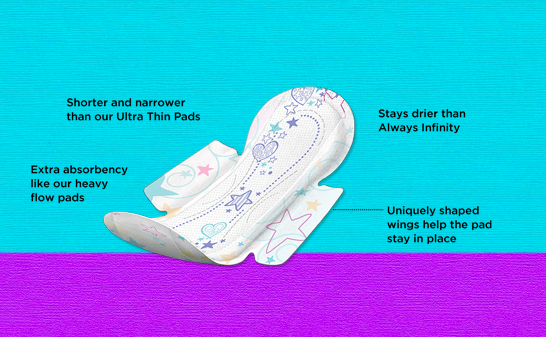Guest Post by Victoria Velding
On a recent trip to the  store I came across U by Kotex for Tweens. It seems this product has been on the market for a number of years, but since I don’t frequent the femcare aisle on a regular basis, I only recently discovered it. Immediately I took issue with its messages. What concerns me is not the existence of the product (that in itself is an entirely separate conversation), as certainly those of the tween age menstruate and need to have products available for their use. No, what I take issue with is the packaging and marketing of the product—the obvious exploitation of the consumer, the mixed messages it sends, and the body and self-esteem issues it exacerbates.
store I came across U by Kotex for Tweens. It seems this product has been on the market for a number of years, but since I don’t frequent the femcare aisle on a regular basis, I only recently discovered it. Immediately I took issue with its messages. What concerns me is not the existence of the product (that in itself is an entirely separate conversation), as certainly those of the tween age menstruate and need to have products available for their use. No, what I take issue with is the packaging and marketing of the product—the obvious exploitation of the consumer, the mixed messages it sends, and the body and self-esteem issues it exacerbates.
The box itself is a classic example of how marketers attempt to attract the tween consumer: glitter, bright colors, and “cutesy” designs. Must we cover everything in glitter just to designate it as for tweens only? The box is also covered in hearts and stars, a theme I would later discover is represented on the contents inside the box as well. The U by Kotex products are notorious for being packaged in a variety of colors (red excluded, of course). When the U by Kotex line was introduced, the brand sought to change the conversation about women’s health and challenge menstrual stigma. I was not surprised to see the tween version offered in multiple colors, nor did it surprise me when I researched the product online and discovered the wrappers also have hearts and stars on them. The designs cleverly resemble drawings from a young girl’s notebook. The U by Kotex website even describes the pads as having “vibrant colors with cool patterns” as if that is going to get a tween girl excited about menstruating! What really surprised me, however, was that there are hearts and stars on the actual pad. Designs! On the pad! Do you know what else has designs on them? Infant diapers.
 Menstruating is often seen as a rite of passage, and menarche, as Janet Lee ascertained, represents the heterosexualization of young girls. By taking this rather adult concept and adding designs to the packaging and actual product, Kotex is infantilizing the tween consumer and, in a sense, the act of menstruating. Pads, like infant diapers, are intended to absorb bodily fluids, and these pads, just like infant diapers, come with cute designs on them.
Menstruating is often seen as a rite of passage, and menarche, as Janet Lee ascertained, represents the heterosexualization of young girls. By taking this rather adult concept and adding designs to the packaging and actual product, Kotex is infantilizing the tween consumer and, in a sense, the act of menstruating. Pads, like infant diapers, are intended to absorb bodily fluids, and these pads, just like infant diapers, come with cute designs on them.
While I was immediately drawn to the glittery package labeled “tween,” it was actually the words in smaller print—“protection for smaller sizes”—that really drew me into the product and caused me a bit of concern. I couldn’t help but think of myself and my tween niece when I saw this. As a tween, I did not require, nor does my tween niece require, a pad that presumably offers less surface area of protection than an adult pad. Tweens want to fit in, to be accepted, to not draw too much attention to themselves. How might a tween feel when she can’t buy the product designed specifically for her age-group because her body is not the size Kotex has deemed it should be? There is a bevy of research on girls and women and body image issues, with many describing the pressure to adhere to society’s idealized conception of the thin female form. Must the slightly larger than “average” tween be made to feel bad about herself, or not “normal” because she needs to use the same femcare product as her teen sister or mom, and not the same one as her tween friends?
The issue, however, concerns not only overweight tweens, but also petite adult women. U by Kotex for Tweens might actually be the perfect size for some adult women, women who have difficulty finding products in their sizes that are not intended for children. Must we continue to infantilize these women by offering “protection for smaller sizes” that is adorned with hearts and stars?
While a pad for “smaller sizes” may be needed, I question Kotex’s approach to specifically targeting the tween consumer. Girls are taught that menstruating is part of growing up, yet a product intended specifically for their menstruating body has elements that are strikingly similar to an infant’s diaper. Tweens are at a confusing time in their lives, experiencing social, emotional, and physiological changes. The mixed messages sent by this product line are only exacerbating their confusion about what it means to grow-up, to menstruate, and to be a girl.
Victoria Velding is a Visiting Assistant Professor of Sociology at West Virginia University. Her research interests include tweens, gender, and sexuality.

